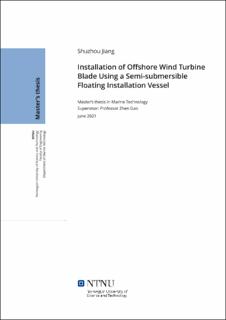| dc.contributor.advisor | Zhen, Gao | |
| dc.contributor.author | Shuzhou, Jiang | |
| dc.contributor.author | Taewoo, Kim | |
| dc.date.accessioned | 2021-09-24T17:32:34Z | |
| dc.date.available | 2021-09-24T17:32:34Z | |
| dc.date.issued | 2021 | |
| dc.identifier | no.ntnu:inspera:78668897:51019422 | |
| dc.identifier.uri | https://hdl.handle.net/11250/2781533 | |
| dc.description.abstract | Med utviklingen av moderne teknologi blir vindenergi brukt oftere og oftere, spesielt offshore vindkraft. Bruk av vindkraft til havs har gradvis blitt en viktig trend. Denne studien simulerer installasjon av kniver I en vindmøllepark offshore i Nordsjøen og studerer bevegelsen.
Denne oppgaven simulerer hovedsakelig bevegelse av vindturbinblader til havs under installasjonsprosessen etter å ha blitt løftet opp av et flytende fartøy. Programvaren SIMA brukes til å utføre dette simuleringsarbeidet. Bladet er valgt fra offshore vindturbinmodell DTU 10 MW. Den aerodynamiske kraften kommer fra TurbSim-programvaren. De kombinerte miljøforholdene til de komplekse uregelmessige bølgene og turbulent vinden under installasjonen av vindturbinblad til havs blir spaltet i flere enkle miljøforhold for analyse.
Denne oppgaven simulerer henholdsvis vanlige bølger, konstant vind, uregelmessige bølger og turbulente vinder. Forskjellige enkeltforhold blir analysert for å finne effekten av forskjellige enkeltforhold på bevegelsen til vindturbinbladet til havs når det løftes. De kombinerte situasjonene med uregelmessige bølger og turbulent vind er også simulert. Studien fant at når det flytende fartøyet brukes til å installere vindturbinbladet til havs, anbefales det å stille den opprinnelige bladhellingvinkelen til rundt -9 grader for å redusere vindkraften som havvindturbinbladet opplever. Samtidig ble det også funnet at når det flytende fartøyet brukes til å installere vindturbinbladet til havs, er bladets bevegelse relatert til det flytende fartøyet som påvirkes av bølgekrefter, og vindstyrken påvirker også bladets bevegelse. | |
| dc.description.abstract | With the development of modern technology, wind energy is used more and more frequently, especially offshore wind energy. The use of offshore wind energy has gradually become an important trend. This study simulates the installation of blades in an offshore wind turbine farm located in the North Sea and studies its movement.
This thesis mainly simulates the motion of offshore wind turbine blades during the installation process after being lifted to by a floating vessel. The software SIMA is used to carry out this simulation work. The blade is selected from DTU 10 MW offshore wind turbine model. The aerodynamic force comes from the TurbSim software. The combined environmental conditions of the complex irregular waves and turbulent wind during the installation of offshore wind turbine blades are decomposed into several simple environmental conditions for analysis.
This thesis simulates regular waves, constant winds, irregular waves and turbulent winds respectively. Different single conditions are analyzed to find the effect of different single conditions on the motion of the offshore wind turbine blade when it is being lifted. The combined situations of irregular waves and turbulent wind are also simulated. The study found that when using the floating vessel to install the offshore wind turbine blade, it is recommended to set the original blade pitch angle to around -9 degrees to reduce the wind force experienced by the offshore wind turbine blade. At the same time, it was also found that when the floating vessel is used to install the offshore wind turbine blade, the motion of the blade is related to the floating vessel affected by wave forces and the wind force affects the blade motion as well. | |
| dc.language | eng | |
| dc.publisher | NTNU | |
| dc.title | Installation of Offshore Wind Turbine Blade Using a Semi-submersible Floating Installation Vessel | |
| dc.type | Master thesis | |
